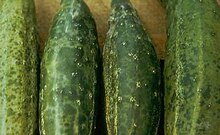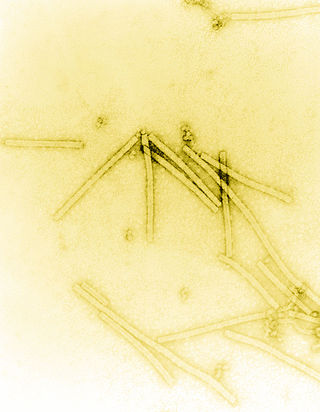
Tobacco mosaic virus (TMV) is a positive-sense single-stranded RNA virus species in the genus Tobamovirus that infects a wide range of plants, especially tobacco and other members of the family Solanaceae. The infection causes characteristic patterns, such as "mosaic"-like mottling and discoloration on the leaves. TMV was the first virus to be discovered. Although it was known from the late 19th century that a non-bacterial infectious disease was damaging tobacco crops, it was not until 1930 that the infectious agent was determined to be a virus. It is the first pathogen identified as a virus. The virus was crystallised by Wendell Meredith Stanley. It has a similar size to the largest synthetic molecule, known as PG5.

Plant viruses are viruses that affect plants. Like all other viruses, plant viruses are obligate intracellular parasites that do not have the molecular machinery to replicate without a host. Plant viruses can be pathogenic to vascular plants.

Papaya ringspot virus (PRSV) is a pathogenic plant virus in the genus Potyvirus and the virus family Potyviridae which primarily infects the papaya tree.

Alfalfa mosaic virus (AMV), also known as Lucerne mosaic virus or Potato calico virus, is a worldwide distributed phytopathogen that can lead to necrosis and yellow mosaics on a large variety of plant species, including commercially important crops. It is the only Alfamovirus of the family Bromoviridae. In 1931 Weimer J.L. was the first to report AMV in alfalfa. Transmission of the virus occurs mainly by some aphids, by seeds or by pollen to the seed.
Asparagus virus 1 (AV-1) is one of the nine known viruses that infects asparagus plants. It is a member of the genus Potyvirus in the family Potyviridae. Initially reported by G. L Hein in 1960, it causes no distinct symptoms in asparagus plants. The only known natural plant host is the asparagus. It is spread by aphid vectors, which means that aphids do not cause the AV-1, but they do spread it.
Bean yellow mosaic virus is a plant pathogenic virus in the genus Potyvirus and the virus family Potyviridae. Like other members of the Potyvirus genus, it is a monopartite strand of positive-sense, single-stranded RNA surrounded by a capsid made for a single viral encoded protein. The virus is a filamentous particle that measures about 750 nm in length. This virus is transmitted by species of aphids and by mechanical inoculation.
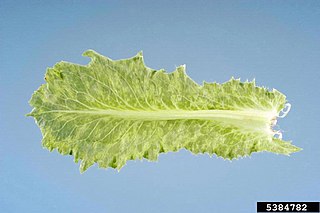
Bidens mottle virus (BiMoV) is a pathogenic plant virus in the plant virus family Potyviridae. BiMoV is a flexuous filamentous particle, 720 nm long, and belongs to the Potyviridae genus Potyvirus. Like other viruses in this genus, Bidens mottle virus is transmitted both mechanically by sap and by aphids in a stylet-borne fashion.
Clover yellow mosaic virus (ClYMV) is a plant pathogenic virus in the genus Potexvirus and the virus family Alphaflexiviridae. Its flexuous rod-shaped particles measure about 539 nm in length.

Maize dwarf mosaic virus (MDMV) is a pathogenic plant virus of the family Potyviridae. Depending on the corn plant’s growth stage, the virus can have severe implications to the corn plant’s development which can also result in economic consequences to the producer of the crop.
Papaya mosaic virus (PapMV) is a plant pathogenic virus in the genus Potexvirus and the family Alphaflexiviridae. PapMV is a filamentous, flexuous rod, 530 nm in length.
Peanut stunt virus (PSV) is a plant pathogenic virus in the family Bromoviridae. It is a member of the genus Cucumovirus. The members of this genus are positive-stranded RNA viruses with a multipartite genome. The virus particles have an isometric or spherical shape.
Pepper mottle virus (PepMoV) is a plant pathogenic virus in the genus Potyvirus and the virus family Potyviridae. Like other members of the Potyvirus genus, PepMV is a monopartite strand of positive-sense, single-stranded RNA surrounded by a capsid made for a single viral encoded protein. The virus is a filamentous particle that measures about 737 nm in length. Isolates of this virus has been completely sequenced and its RNA is 9640 nucleotides long. This virus is transmitted by several species of aphids in a nonpersitant manner and by mechanical inoculation.
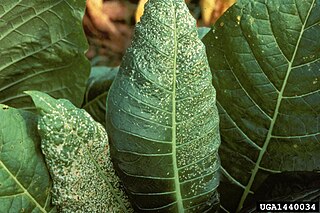
Tobacco etch virus (TEV) is a plant virus in the genus Potyvirus and family Potyviridae. Like other members of the genus Potyvirus, TEV has a monopartite positive-sense, single-stranded RNA genome surrounded by a capsid made from a single viral encoded protein. The virus is a filamentous particle that measures about 730 nm in length. It is transmissible in a non-persistent manner by more than 10 species of aphids including Myzus persicae. It also is easily transmitted by mechanical means but is not known to be transmitted by seeds.
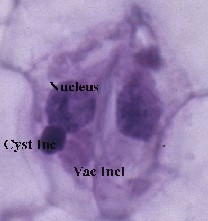
Tobacco ringspot virus (TRSV) is a plant pathogenic virus in the plant virus family Secoviridae. It is the type species of the genus Nepovirus. Nepoviruses are transmitted between plants by nematodes, thrips, mites, grasshoppers, and flea beetles. TRSV is also easily transmitted by sap inoculation and transmission in seeds has been reported. In recent cases it has also been shown to appear in bees, but no transmission to plants from bees has been noted.
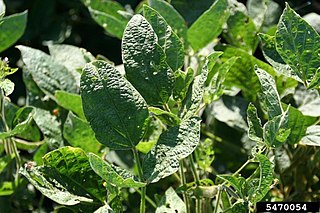
Soybean mosaic virus (SMV) is a member of the plant virus genus Potyvirus. It infects mainly plants belonging to the family Fabaceae but has also been found infecting other economically important crops. SMV is the cause of soybean mosaic disease that occurs in all the soybean production areas of the world. Soybean is one of the most important sources of edible oil and proteins and pathogenic infections are responsible for annual yield losses of about $4 billion in the United States. Among these pathogens, SMV is the most important and prevalent viral pathogen in soybean production worldwide. It causes yield reductions of about 8% to 35%, but losses as high as 94% have been reported.

Orthotospovirus is a genus of negative-strand RNA viruses, in the family Tospoviridae of the order Bunyavirales, which infects plants. Tospoviruses take their name from the species Tomato spotted wilt orthotospovirus (TSWV) which was discovered in Australia in 1919. TSWV remained the only known member of the family until the early 1990s when genetic characterisation of plant viruses became more common. There are now at least twenty species in the genus with more being discovered on a regular basis. Member viruses infect over eight hundred plant species from 82 different families.
Commelina mosaic virus (CoMV) is a plant pathogenic virus in the genus Potyvirus and the virus family Potyviridae. Like other members of the Potyvirus genus, CoMV is a monopartite strand of positive-sense, single-stranded RNA surrounded by a capsid made for a single viral encoded protein. The virus is a filamentous particle that measures about 707-808 nm in length. This virus is transmitted by two species of aphids, Myzus persicae and Aphis gossypii, and by mechanical inoculation.

Squash mosaic virus (SqMV) is a mosaic virus disease common in squash plants and other plants, including melons, of the family Cucurbitaceae. It occurs worldwide. It is transmitted primarily by beetles, including the leaf beetle, spotted cucumber beetle, and 28-spotted ladybird beetle, as well as some other beetles. Plants are infected by the saliva expelled by the beetles as they feed upon the plant. The beetles acquire the virus by feeding upon an infected plant and can retain the virus in their bodies for up to 20 days. Unlike some other mosaic viruses that infect squashes, SqMV is not spread by aphids. In melons it can be spread by seeds. The results are dark green mosaic, blistering, vein clearing, yellowing of leaves, and hardening. Symptoms include "pronounced chlorotic mottle, green veinbanding, and distortion of leaves". Fruits of infected plants are also affected, becoming mottled and misshaped. There are two strains of this virus: strain 1 has a greater effect on melons than squash while the opposite is true of strain 2.
The cardamom mosaic virus (CdMV) is a mosaic virus that affects the production of green cardamom (E. cardamomum). It is a member of the genus Macluravirus (recognized under the family Potyviridae by ICTV in 1988), and is transmitted through aphids (P.caladii) and infected rhizomes, the former in a non-persistent manner.
Carrot virus Y (CarVY) is a (+)ss-RNA virus that affects crops of the carrot family (Apiaceae), such as carrots, anise, chervil, coriander, cumin, dill and parsnip. Carrots are the only known crop to be infected in the field. Infection by the virus leads to deformed roots and discolored or mottled leaves. The virus is spread through insect vectors, and is currently only found in Australia.
